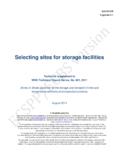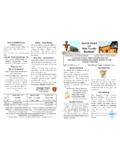Transcription of Building security and fire protection - who.int
1 ` supplement 4 WHO Vaccine Building security and fire protection Technical supplement to WHO Technical Report Series, No. 961, 2011 Annex 9: Model guidance for the storage and transport of time and temperature sensitive pharmaceutical products August 2014 World Health Organization 2014 WHO Press, World Health Organization, 20 Avenue Appia, 1211 Geneva 27, Switzerland (tel.: +41 22 791 3264; fax: +41 22 791 4857; e-mail: Requests for permission to reproduce or translate WHO publications whether for sale or for noncommercial distribution should be addressed to WHO Press, at the above address (fax: +41 22 791 4806; e-mail: The designations employed and the presentation of the material in this publication do not imply the expression of any opinion whatsoever on the part of the World Health Organization concerning the legal status of any country, territory, city or area or of its authorities, or concerning the delimitation of its frontiers or boundaries.))
2 Dotted lines on maps represent approximate border lines for which there may not yet be full agreement. The mention of specific companies or of certain manufacturers products does not imply that they are endorsed or recommended by the World Health Organization in preference to others of a similar nature that are not mentioned. Errors and omissions excepted, the names of proprietary products are distinguished by initial capital letters. ` All reasonable precautions have been taken by the World Health Organization to verify the information contained in this publication. However, the published material is being distributed without warranty of any kind, either expressed or implied. The responsibility for the interpretation and use of the material lies with the reader.
3 In no event shall the World Health Organization be liable for damages arising from its use. The named authors alone are responsible for the views expressed in this publication. Technical supplement : Building security and fire- protection 3 Acknowledgments The author of this document is Dr Clare Barker, Principal Consultant, Fire Engineering Europe, Exova Warringtonfire, UK. Technical supplement : Building security and fire- protection 4 Contents Acknowledgments .. 3 Contents .. 4 Abbreviations .. 6 Glossary .. 7 1. Introduction .. 8 Requirements .. 8 8 Target audience .. 9 Associated materials and equipment .. 9 2. Guidance .. 10 Site security and emergency access .. 10 General Building security .
4 10 Controlled and hazardous substances areas .. 11 Fire detection systems .. 11 Fire suppression equipment .. 11 Sprinkler systems .. 12 Smoke ventilation systems .. 12 Compartmentation .. 13 Fire prevention, training and control procedures .. 13 Risk assessment .. 13 Fire prevention .. 13 Fire safety training .. 14 Fire control procedures .. 15 References .. 16 Annex 1 SOP: Fire safety housekeeping .. 18 Policy and objectives .. 18 Policy .. 18 Objectives .. 18 Responsibility .. 18 Associated materials and equipment .. 18 Procedure .. 18 Reducing ignition sources .. 18 Reducing fuel load .. 19 Technical supplement : Building security and fire- protection 5 Maintenance of fire protection measures.
5 19 Related documents .. 20 Annex 2 SOP: Routine inspection and maintenance .. 21 Policy and objectives .. 21 Policy .. 21 Objectives .. 21 Responsibility .. 21 Associated materials and equipment .. 21 Procedure .. 21 Daily inspections .. 21 Weekly inspections .. 22 Monthly inspections .. 23 Three-monthly inspections .. 24 Six-monthly 24 Yearly inspections .. 25 Related documents .. 26 Annex 3 SOP: Fire drills .. 27 Policy and objectives .. 27 Policy .. 27 Objectives .. 27 Responsibility .. 27 Associated materials and equipment .. 27 Procedure .. 27 Conducting test evacuations .. 27 Related documents .. 29 Revision history .. 30 Technical supplement : Building security and fire- protection 6 Abbreviations BS British Standard CCTV Closed Circuit Television EHS Environmental, Health and Safety NFPA National Fire protection Association (United States) SLA Service Level Agreement SOP Standard Operating Procedure TTSPP Time and Temperature-Sensitive Pharmaceutical Product Technical supplement : Building security and fire- protection 7 Glossary Controlled or hazardous products: TTSPPs and other products with high illicit value: poisons, narcotics, psychotropic products, inflammable or explosive substances and radioactive materials.
6 Key fob: A small security device with built-in authentication used to control entry to a Building and/or entry through internal doors within a Building . Pharmaceutical product: Any product intended for human use or veterinary product intended for administration to food producing animals, presented in its finished dosage form, that is subject to control by pharmaceutical legislation in either the exporting or the importing state and includes products for which a prescription is required, products which may be sold to patients without a prescription, biologicals and vaccines. Medical devices are not included1. Service Level Agreement (SLA): A service level agreement or contract is a negotiated agreement between the customer and service provider that defines the common understanding about materials or service quality specifications, responsibilities, guarantees and communication mechanisms.
7 It can either be legally binding, or an information agreement. The SLA may also specify the target and minimum level performance, operation or other service attributes2. Standard Operating Procedure (SOP): A set of instructions having the force of a directive, covering those features of operations that lend themselves to a definite or standardized procedure without loss of effectiveness. Standard operating policies and procedures can be effective catalysts to drive performance improvement and improve organizational results. Third Party Accreditation: Accreditation or certification by an organization that issues credentials or certifies third parties against official standards as a means of establishing that a contractor is competent to undertake a specific type of work.
8 Third party accreditation organizations are themselves formally accredited by accreditation bodies; hence they are sometimes known as "accredited certification bodies". The accreditation process ensures that their certification practices are acceptable, typically meaning that they are competent to test and certify third parties, behave ethically and employ suitable quality assurance. Time and temperature sensitive pharmaceutical product (TTSPP): Any pharmaceutical good or product which, when not stored or transported within pre-defined environmental conditions and/or within pre-defined time limits, is degraded to the extent that it no longer performs as originally intended. 1 Definition from WHO/ Rev 1 Sept 2009.
9 Proposal for revision of WHO good distribution practices for pharmaceutical products Draft for comments. 2 Definition from IATA. 2013/2014 Perishable Cargo Regulations (ePCR) & Temperature Control Regulations (eTCR) Technical supplement : Building security and fire- protection 8 1. Introduction This technical supplement has been written to amplify the recommendations given in WHO Technical Report Series No. 961, 2011, Annex 9: Model guidance for the storage and transport of time- and temperature-sensitive pharmaceutical products3. Requirements Ensure that buildings used to store TTSPPs have sufficient security to prevent unauthorized access and to prevent misappropriation of goods. Ensure that all areas that are used to store controlled or hazardous TTSPPs are: a.
10 Dedicated, securely locked facilities that fully comply with all legislative and regulatory requirements applicable in the country where the store is located; b. Only accessible to authorized staff; c. Protected by automatic intruder and/or fire and smoke, and/or chemical and/or radiological sensor alarm systems appropriate to the type(s) of product being stored; d. Designed to be explosion-proof, where explosive TTSPPs are stored; and e. Continuously monitored by security staff or by a qualified external security company. Continuous monitoring may be on-site or remote. Provide suitable fire detection and fire-fighting equipment, including fire hydrants, in all TTSPP storage areas and ensure that: a. Systems and equipment are appropriate for the class of occupancy and product storage arrangements and are approved by the local fire authority; and b.














